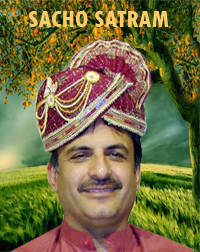Hazir Swaroop Sai Sadhram Saheb beautifully emphasized the significance of celebrating auspicious days and festivals. Saijan explained that these celebrations are held each year to remind us of their deeper purpose—cherishing the teachings of great saints, revered Mahapurushas, divine beings, and significant universal events that shape our lives.
Saijan beautifully explained the significance of Makar Sankranti as a celebration of knowledge, wisdom, intelligence, sensibility, love, and sweetness. This auspicious occasion enriches our lives and the world by conveying the profound message of attaining oneness with Parmatma.
Saijan also highlighted the divine coincidence of Makar Sankranti 2025 aligning with the 115th Varsi Maha Utsav of Shahanshah Satguru Swami Satramdas Sahib, making the celebrations even more meaningful.
Saijan enlightened everyone about the significance of Makar Sankranti, explaining that it marks the auspicious day when the Sun begins its journey closer to the North. As we reside in the northern region, this closeness is celebrated, bringing longer days and shorter nights, symbolizing the diminishing of darkness.
This transition is known as Uttarayan, meaning the Sun’s movement toward the North.
During this period, the Sun begins its gradual movement toward the North, and each minute shift is referred to in Hindi as “Til Til,” signifying a movement as small as a sesame seed. This slow and steady transition is symbolized by the use of sesame seeds (Til) on the auspicious day of Makar Sankranti.
The Sun’s journey toward the North brings renewed energy, joy, and prosperity into our lives. Incorporating sesame seeds in the celebrations highlights this divine movement, as they not only carry symbolic significance but also offer immense health benefits.
We celebrate the Sun’s movement toward the North because it brings longer days and a renewed sense of awareness into our lives.
The Sun symbolises light, brightness, radiance, and illumination. Its approach toward us carries a profound message: just as the Sun spreads its light, we too should align with its brilliance and let our minds shine. By embracing this illumination, we can consciously and effectively use our intelligence and wisdom to lead purposeful and meaningful lives.
Hazir Swaroop Sai Sadhram Saheb shared profound insights on the value and importance of our eyes. He explained that our eyes are a divine blessing, enabling us to see and experience the light around us. It is through light that we can truly perceive the world, as darkness obscures our vision. He emphasised that our eyesight protects us, guiding us and preventing us from stumbling or falling.
It is not just about avoiding physical stumbling or falling but also about being mindful of moral shortcomings.
While we cannot always control what our eyes encounter—whether right or wrong—it is up to us to focus on what is uplifting and virtuous. Choosing to gaze upon good things, such as great Masters, the murtis of Devis and Devtas, temples, saints, and Mahatmas, is within our control. It is our responsibility to use our vision to seek what is morally enriching rather than what may lead us astray.
The more we consciously and reverently focus on good and virtuous things, the more we accumulate *punya* (merit). Conversely, when we fix our gaze on something morally unethical, it leads to the accumulation of sins in our life.
Our eyes are meant to seek what is righteous and pure, helping us earn *punya*. When we look at something with good intentions and a sense of piety, our eyes naturally lower with humility and reverence. In contrast, when we are drawn to materialistic beauty or superficial attractions for fleeting pleasure, our eyes widen with desire, yet fail to bring inner joy or fulfilment.
When we gaze upon the Murti of our Satguru, our eyes naturally close, and our inner selves are illuminated. However, much like a fish that never closes its eyes, if we focus on superficial attractions, we, too, become like that fish trapped in the net of fishermen. In the same way, we get trapped in the materialistic world and struggle for freedom within the cycle of birth and death.
God has blessed us with eyelids, and our eyes blink approximately 14 to 17 times per minute. This natural blinking encourages thoughtful observation, as staring at something with wide-open eyes without blinking hinders wise thinking. The act of blinking helps us focus on the external world with greater sensibility and awareness.
Hazir Swaroop Sai Sadhram Saheb explained that we are blessed with an abundance of sunlight as the mighty Sun moves toward us in the North. This marks the arrival of a time when humanity should embrace the wealth of knowledge and wisdom, using it for the righteous growth and progress of their inner selves.
We must make a clear choice between right and wrong for our own betterment in life. Saijan emphasised that when we apply our wisdom and live virtuously and righteously, our fortune and fate align in our favor, leading to the fruitful harvest of our efforts.
Saijan shared that as humans, we often turn to seva, good karmas, and prayers only when facing challenges in life. However, once we overcome these difficulties, we tend to forget to be grateful to God and fall back into our old habits.
We tend to remember God only when we are sad, unhappy, or in trouble, but not during times of happiness. This is because we struggle to keep our ego in check during moments of joy and prosperity.
To celebrate the Sun’s movement toward the North, we prepare, consume, and distribute ladoos made from sesame and jaggery. Jaggery, which is sweet and derived from sugarcane, symbolises the joy of the harvest season, while sesame seeds represent strength and energy. With genuine humility, we embrace this time with renewed vigor and vitality.
We should always harbor good thoughts for everyone, never allowing jealousy, enmity, or ill intentions to take root. Our focus should be on the well-being and betterment of all.
As we prosper and progress, we must remember to stay humble.
Jaggery and sesame seeds convey the message that if we possess power, we should also be loving. By combining both love and strength, we can work together to make the world a better place for all.
As the Sun moves toward the North, it passes from the zodiac sign Sagittarius, known as Dhanu in Hindi, into Capricorn, called Makar. This transition is why this period is called Makar Sankranti.
The ruler of Makar is Yamma, who is the son of the Sun. Therefore, as the Sun enters Yamma’s house, it signifies a deeper message: we should not overlook our children, even when they are not behaving appropriately. Instead, we must continue striving to uplift and guide them toward improvement.
Makar Sankranti is a time to guide and improve our children by setting a positive example through our own lifestyle. If we live with wisdom and integrity, we can inspire our children to follow in our footsteps, adopting the values we demonstrate. Just as the Sun is illuminated and illuminates Makar, we should strive to embody good character so that our children learn from the example we set in our own lives.
We must strive to be bright in our character, like the Sun, so that we can illuminate the minds of our children and bring true joy and prosperity into their lives.
The Sun symbolises power, knowledge, and pure wisdom, which is why it has the ability to illuminate the Makar Rashi (Capricorn Zodiac), whose ruler is Yamma, the Sun’s own son.
Hazir Swaroop Sai Sadhram Saheb further illustrated his point by referencing Shree Hanuman Ji. He explained that Shree Hanuman Ji received all his knowledge and wisdom from the Sun God, becoming so powerful and enlightened that he was always ready to help others and rescue them from challenging and complex situations. Saijan emphasised that if we read the Shrimad Ramayana, we will see how Hanuman Ji consistently saved people trapped in difficult circumstances.
Hazir Swaroop Sai Sadhram Saheb emphasised that we should use our intelligence and wisdom to perform good deeds for the betterment of everyone’s life. We must never make excuses to justify our wrongdoings.
If we live with goodness, maintain a clean image, and enjoy a life of contentment, we should continue on this righteous path. We must resist falling into bad habits or indulging in wrongdoings for temporary pleasures and fleeting comforts. After experiencing a life of happiness and contentment, it becomes very challenging and painful to endure sadness and distress.
This is why we must always remain alert and aware, ensuring we do not fall into anything that brings disgrace to our happy lives.
We have evolved through countless forms of life to be born as humans, and now it is up to us to decide how we want to progress. We can choose to advance through good deeds, dedicating time to Naam, Dhyan, Simran, and Seva, or we can regress by adopting bad habits and wasting time on inappropriate actions. If we improve our lives as humans, we will attain divine greatness, but if we stray from the right path and indulge in harmful behaviours, the opposite will occur, and we will degrade ourselves, transforming from sensible humans into wild beasts.
Saijan explained that when we start a new business, we strive to make progress by securing good deals and increasing profits. However, if we fail to take our business seriously, make poor decisions, and neglect sensible deals, we will face losses and lose our means of living a good life. The same principle applies to our own lives. We are born as humans with inherent humanity, true inner power, intelligence, and wisdom. These qualities are given to us so we can progress and attain eternal peace. But if we take life lightly, fail to honour the blessings we have, and waste our time engaging in harmful behaviours, we forfeit our right to peace and, in return, will face the consequences of our actions.
Makar Sankranti brings favourable climatic conditions, and just as the weather improves, we too should shed laziness, negativity, and selfishness. We should become pure and positive by cultivating inner self-awareness, performing good deeds, and engaging in Naam, Dhyan, and Simran. This will enhance our lives, leading to continuous progress and the attainment of greatness in humanity.
When we begin our day with positive actions, our entire day will be filled with positivity and progress.
Saijan said that Makar Sankranti is a day dedicated to knowledge, wisdom, sensibility, remembrance of Parmatma, and positivity.
It is also a day for self-improvement, where we set a good example through our own lifestyle for our children to follow. By doing so, they can use their inner positive energy with conscious awareness to become powerful and sensible. This will help them prosper and progress in all their endeavors as humans, spreading happiness in the world by uplifting one another.
Hazir Swaroop Sai Sadhram Saheb shared a message from the teachings of Shahanshah Satguru Swami Sai Satram Das Saheb, stating that the first thing we should do in the morning is to have Darshan of the sacred Murti of Shahanshah Satguru Sai Satram Das Saheb, as well as the temple in our home. By making the first sight of our day the Murti of Sai, the entire day will be filled with positivity, true joy, and it will be a progressive and peaceful day.
Hazir Swaroop Sai Sadhram Saheb, emphasizing the profound teachings of Shahanshah Satguru Swami Sai Satramdas Saheb, explained that by having the pious Darshan of the sacred Murti of Shahanshah Satguru Swami Sai Satramdas Saheb, and after refreshing ourselves in the morning, spending time in the remembrance of Satguru through Naam, Jaap, and Simran, we can make the most of the blessings and values we have received as humans. When we step outside, the blessings of Satguru and good fortune accompany us, guiding us through a positive and progressive day. This daily practice enhances our lifestyle, elevates us to the greatness of humanity, and leads us to oneness with our Parmatma.



